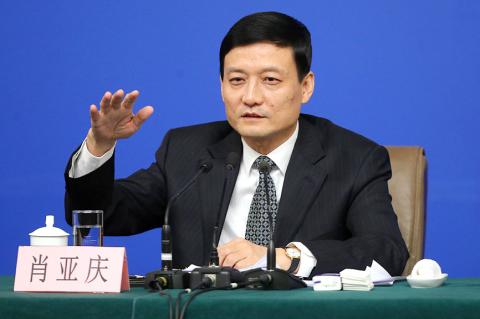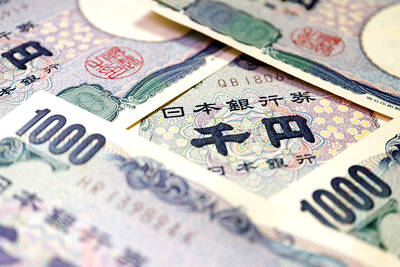China is to combine more of its biggest state-owned enterprises as part of a sweeping plan to cut overcapacity in the US$18 trillion sector but would not see the widespread layoffs that accompanied a similar overhaul in the 1990s, a senior regulator said.
Reform of China’s state-owned enterprises must balance many interests, especially those of employees, China’s State-Owned Assets Supervision and Administration Commission Chairman Xiao Yaqing (肖亞慶) told a briefing in Beijing on Saturday.
Big state-owned enterprises will be made stronger while duplication will be eliminated, he said.

Photo: EPA
“We are in the business of growing bigger and better,” Xiao said at the briefing, held on the sidelines of China’s annual legislative session.
He said that reform is split into two tracks: Cut overcapacity in some industries while capturing growth in others like aerospace, nuclear power, high speed rail, smart grid technology and renewable energy.
Xiao’s remarks come as economic growth slows in China and state-owned companies have become plagued by overcapacity and inefficiency.
Last year, the number of enterprises administered by Xiao’s regulator dropped from 112 to 106, with high-profile mergers by China Ocean Shipping Group (中遠集團) and China Shipping Group (中海集團), as well as two trainmakers.
Xiao said the consolidation that occurred last year was going “not too bad,” and more can be expected this year.
Xiao said China will not see the sort of layoffs recorded in the last major round of state-owned enterprises reform in the 1990s, when about 60,000 firms were closed and 40 million workers lost their jobs.
This time, China has announced plans for 1.8 million job losses in the coal and steel sectors. Even so, not all workers in “old economy” industries such as coal and steel have skills that are transferable elsewhere. China’s economy slowdown has fanned jitters and broader panic as the growth sinks to its lowest in two decades.
“The economic slowdown is within expectations, but what has exceeded our expectations is the panic,” Xiao said. “Panic is more frightful than the downturn — it might worsen the downturn.”
In December last year, China set a two-year deadline for money-losing enterprises owned by the central government to improve their performance, with firms that suffer losses for three straight years liable to be shut down.
Among those companies targeted for mergers could be the airline sector.
Separately, China’s judicial authorities vowed to do more to combat financial crimes in the coming year, as the economy slows and leaders remain concerned that financial risks might lead to higher unemployment and social unrest.
Chief prosecutor Cao Jianming (曹建明) yesterday said in his annual report to the nation’s top legislature that his department would prioritize investigations into finance, securities and insurance to “guarantee a healthy development of capital market.”
The Supreme People’s Procuratorate, China’s top prosecuting body, plans to tackle financial crimes involving illegal fundraising to protect the public and focus on contract fraud crimes to establish a “fair and orderly environment of market competition,” he said.
Supreme People’s Court President Zhou Qiang (周強) said in a separate report to the Chinese National People’s Congress in Beijing that the top court would strengthen oversight of financial crimes involving the Internet.
Chinese courts last year handled 1.4 million cases involving peer-to-peer lending worth 821 billion yuan (US$126 billion), Zhou said.
More than 72,000 people were convicted for crimes involving illegal fundraising and peer-to-peer lending.
Regulators have also targeted the booming online loan industry by investigating one of the largest peer-to-peer brokers, Ezubao (e租寶).

AI TALENT: No financial details were released about the deal, in which top Groq executives, including its CEO, would join Nvidia to help advance the technology Nvidia Corp has agreed to a licensing deal with artificial intelligence (AI) start-up Groq, furthering its investments in companies connected to the AI boom and gaining the right to add a new type of technology to its products. The world’s largest publicly traded company has paid for the right to use Groq’s technology and is to integrate its chip design into future products. Some of the start-up’s executives are leaving to join Nvidia to help with that effort, the companies said. Groq would continue as an independent company with a new chief executive, it said on Wednesday in a post on its Web

RESPONSE: The Japanese Ministry of Finance might have to intervene in the currency markets should the yen keep weakening toward the 160 level against the US dollar Japan’s chief currency official yesterday sent a warning on recent foreign exchange moves, after the yen weakened against the US dollar following Friday last week’s Bank of Japan (BOJ) decision. “We’re seeing one-directional, sudden moves especially after last week’s monetary policy meeting, so I’m deeply concerned,” Japanese Vice Finance Minister for International Affairs Atsushi Mimura told reporters. “We’d like to take appropriate responses against excessive moves.” The central bank on Friday raised its benchmark interest rate to the highest in 30 years, but Bank of Japan Governor Kazuo Ueda chose to keep his options open rather than bolster the yen,

Global server shipments are expected to surge to 15 million units next year, from 4 million units this year, with artificial intelligence (AI) servers accounting for about 30 percent, driven by massive capital spending by major cloud service providers, the Market Intelligence and Consulting Institute (MIC) said on Thursday last week. Major cloud service providers — including Google’s parent company Alphabet Inc, Microsoft Corp, Amazon.com Inc and Meta Platforms Inc — are projected to budget US$450 million for capital expenditure next year, up from US$400 million this year, MIC ICT [information and communications technology] Industry Research Center director Edward Lin

Even as the US is embarked on a bitter rivalry with China over the deployment of artificial intelligence (AI), Chinese technology is quietly making inroads into the US market. Despite considerable geopolitical tensions, Chinese open-source AI models are winning over a growing number of programmers and companies in the US. These are different from the closed generative AI models that have become household names — ChatGPT-maker OpenAI or Google’s Gemini — whose inner workings are fiercely protected. In contrast, “open” models offered by many Chinese rivals, from Alibaba (阿里巴巴) to DeepSeek (深度求索), allow programmers to customize parts of the software to suit their